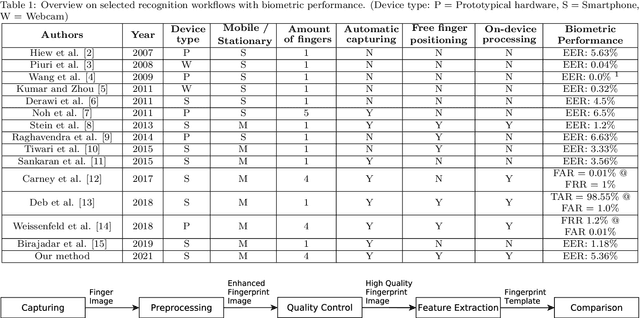Jannis Priesnitz
MCLFIQ: Mobile Contactless Fingerprint Image Quality
Apr 27, 2023Abstract:We propose MCLFIQ: Mobile Contactless Fingerprint Image Quality, the first quality assessment algorithm for mobile contactless fingerprint samples. To this end, we retrained the NIST Fingerprint Image Quality (NFIQ) 2 method, which was originally designed for contact-based fingerprints, with a synthetic contactless fingerprint database. We evaluate the predictive performance of the resulting MCLFIQ model in terms of Error-vs.-Discard Characteristic (EDC) curves on three real-world contactless fingerprint databases using two recognition algorithms. In experiments, the MCLFIQ method is compared against the original NFIQ 2 method and a sharpness-based quality assessment algorithm developed for contactless fingerprint images. Obtained results show that the re-training of NFIQ 2 on synthetic data is a viable alternative to training on real databases. Moreover, the evaluation shows that our MCLFIQ method works more accurate and robust compared to NFIQ 2 and the sharpness-based quality assessment. We suggest considering the proposed MCLFIQ method as a candidate for a new standard algorithm for contactless fingerprint quality assessment.
SynCoLFinGer: Synthetic Contactless Fingerprint Generator
Oct 18, 2021



Abstract:We present the first method for synthetic generation of contactless fingerprint images, referred to as SynCoLFinGer. To this end, the constituent components of contactless fingerprint images regarding capturing, subject characteristics, and environmental influences are modeled and applied to a synthetically generated ridge pattern using the SFinGe algorithm. The proposed method is able to generate different synthetic samples corresponding to a single finger and it can be parameterized to generate contactless fingerprint images of various quality levels. The resemblance of the synthetically generated contactless fingerprints to real fingerprints is confirmed by evaluating biometric sample quality using an adapted NFIQ 2.0 algorithm and biometric utility using a state-of-the-art contactless fingerprint recognition system.
Mobile Touchless Fingerprint Recognition: Implementation, Performance and Usability Aspects
Mar 04, 2021



Abstract:This work presents an automated touchless fingerprint recognition system for smartphones. We provide a comprehensive description of the entire recognition pipeline and discuss important requirements for a fully automated capturing system. Also, our implementation is made publicly available for research purposes. During a database acquisition, a total number of 1,360 touchless and touch-based samples of 29 subjects are captured in two different environmental situations. Experiments on the acquired database show a comparable performance of our touchless scheme and the touch-based baseline scheme under constrained environmental influences. A comparative usability study on both capturing device types indicates that the majority of subjects prefer the touchless capturing method. Based on our experimental results we analyze the impact of the current COVID-19 pandemic on fingerprint recognition systems. Finally, implementation aspects of touchless fingerprint recognition are summarized.
Biometrics in the Era of COVID-19: Challenges and Opportunities
Feb 18, 2021



Abstract:Since early 2020 the COVID-19 pandemic has had a considerable impact on many aspects of daily life. A range of different measures have been implemented worldwide to reduce the rate of new infections and to manage the pressure on national health services. A primary strategy has been to reduce gatherings and the potential for transmission through the prioritisation of remote working and education. Enhanced hand hygiene and the use of facial masks have decreased the spread of pathogens when gatherings are unavoidable. These particular measures present challenges for reliable biometric recognition, e.g. for facial-, voice- and hand-based biometrics. At the same time, new challenges create new opportunities and research directions, e.g. renewed interest in non-constrained iris or periocular recognition, touch-less fingerprint- and vein-based authentication and the use of biometric characteristics for disease detection. This article presents an overview of the research carried out to address those challenges and emerging opportunities.
 Add to Chrome
Add to Chrome Add to Firefox
Add to Firefox Add to Edge
Add to Edge